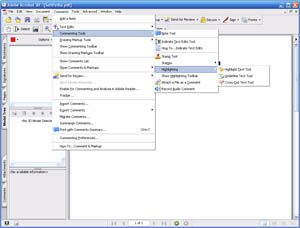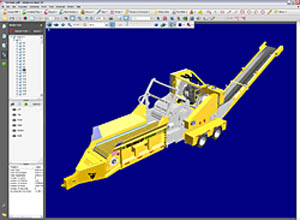|
Adobe Acrobat 3D
Adobe Acrobat 3D targets the 3D CAD
market and those users who need to share 3D concepts with one of the
most revolutionary products to hit the PC application industry in quite
some time.
Adobe® Acrobat® 3D software empowers CAD, CAM, and CAE users to convert
virtually any CAD file to a highly compressed 3D PDF file to enable
3D-based collaboration and CAD data interoperability. Increase
engineering productivity by sharing Adobe PDF files containing precise
geometry and product manufacturing information (PMI) with users of free
Adobe Reader® software to mark up 3D designs, or leverage Adobe PDF
files for downstream manufacturing processes without having to buy CAD
translators. [From Adobe]
In its
essence, Adobe Acrobat 3D allows user to incorporate 3D data directly
into PDF files without the user relying on Universal 3D files (U3D) as
the software now supports a plethora of file formats that include CAD,
CAM, DCC, 3DS, 3DM, ASE, DXF, DGN, IGES, OBJ and even VRML. Creating 3D
PDF files has never been easier with the introduction of such a broad
range of file compatibility, this program is your one stop shop.

Overview of Adobe Acrobat 3D
-
Acrobat 3D version 8 software offers design engineers and technical
publishers a complete and more secure way to collaborate with
extended teams on 3D designs
-
Capture 3D designs from major CAD applications in PDF documents to
provide rich, interactive 3D designs to users of free Adobe Reader
software (version 7.0.78), without requiring expensive CAD or viewer
software
-
Accelerate review cycles, streamline production, help reduce costly
redesigns, and leverage existing CAD assets for technical manuals
and marketing materials
-
Capture 3D designs within Adobe PDF
-
Share 3D designs with extended teams
-
Combine files from multiple applications
-
Accelerate and extend collaboration
-
Protect and control sensitive information
The
installation of Adobe Acrobat 3D was a breeze and it simply
auto-installed once the software was detected on our AMD Phenom 9600
test machine and after a brief installation process, the software was
successfully installed on our Windows Vista 64-bit operating system and
were ready to test this impressive software package. It should be noted
that this software runs on a variety of different Windows based
operating systems.

For
those familiar with Adobe Acrobat Professional 7, the interface is
reminiscent of this software package, however Adobe Acrobat 3D offers
the user a variety of new options, ensuring that their 3D data remains
intact during the file conversion to PDF. This means that your 3D data
is flawlessly implemented into the software package without any loss of
quality or image distortion.
Creating a PDF file is quite a simply process thanks to the innovative
interface of Adobe Acrobat 3D and the user simply needs to select the
"File" menu and then "Create PDF". Once in this menu, the user just
needs to select the way which the file will be created in the software,
whether this is from an external file, scanner or even from 3D capture.
Open
GL users will be pleased to know that the software supports this popular
open-based system which reduces the overall workload of creating these
files. With that said, the options available to user are quite intensive
which means this program is suited for both the novice and the
professional.
Another impressive feature of the software is that by right clicking on
one of your 3D data formats such as 3DS or VRML in Windows Explorer, a
new option is available for the user called "Convert to Adobe PDF" which
truly makes things considerably easy.

Manipulating 3D data in the program offers the user a wide gamut of
different options that we were quite amazed at how much manipulation of
the files is available. Once the 3D data is implemented into a PDF
document, the user can also manipulate that data within the PDF file
itself and can you apply various render and light settings upon creation
which all reflect in the final document.
You
can even add comments to your 3D data within the application and of
course those important security settings which makes this software
package quite appealing to a variety of different business sectors.
Even though 3D data can be large when converted, Adobe Acrobat 3D offers
the user a variety of different quality settings and also enhancement
features to ensure that your files keep their intended view.
Your
3D data can even be edited in the program to produce the best possible
presentation that the user requires. A nifty and useful feature for
Microsoft Office users is the inclusion of the PDF Maker Toolbar that
becomes available in Microsoft Word, Excel and even PowerPoint. Simply
by accessing the toolbar, users can then directly embed a 3D file into
their documents

PC
versus Mac versus Unix! Although Adobe Acrobat 3D is solely intended for
PC users, Adobe have cleverly included a program called the Adobe
Acrobat 3D Unix Capture Utility which broadens the compatibility of this
program even more. The only downside to the program is that there is no
Mac support, however the CAD industry is now almost a PC focused area.
In conclusion, Adobe Acrobat 3D is an extremely powerful program that
not only targets the CAD industry but also the medical field with its
powerful features and cross compatibility.
The
beauty of PDF files is that they can be opened for free on your
computer, provided you have the latest version of this free viewer that
makes this format so popular among a variety of different users.
The
time saving aspects of this program is definitely a huge selling point
for this product and if you are involved in the 3D design industry, than
we would highly recommend that you investigate this product.
Supported file formats in Adobe Acrobat 3D
- 3D Studio ASC (*.asc)
- 3D Studio MAX ASCII (*.ase)
- 3D Studio Mesh (*.3ds, *.prj)
- Autodesk AutoCAD (*.dxf)
- Autodesk Inventor (*.ipt, *.iam)
- CATIA 4 (*.model, *.dlv, *.cgr)
- CATIA 5 (*.catproduct, *.catpart)
- Ideas part and assembly (*.mf1, *arc, *unv, *.pkg)
- Initial Graphics Exchange (*.iges, *.igs)
- JT Open (*.jt)
- Lattice 3D (*.xv3, *.xv0)
- LightWave (*.lw, *.lwo, *.lws)
- MicroStation CAD Graphic (*.dgn)
- Parasolid (*.x_t, *.x_b)
- Pro/ENGINEER (*.prt, *.prt*, *.xpr, *.asm, *.asm*, *.xas)
- Rhinoceros 3D Model (*.3dm)
- Right Hemisphere (.rh)
- Softimage XSI (*.xsi)
- Solid Edge (*.par)
- SolidWorks (*.sldasm, *.sldprt)
- STEP/Standard for the Exchange of Product Model Data
- Stereo Lithography (*.stl)
- Unigraphic Parts and Assemblies (*.prt)
- Universal 3D (*.u3d)
- Virtual Reality Modeling Language (*.vrml, *.wrl)
- Wavefront Object (*.obj)
System Requirement of Adobe Acrobat 3D
-
Intel Pentium 4/Centrino/Xeon/Core Duo (or compatible processor;
Microsoft Windows XP with Service Pack 2 or Windows Vista Home
Premium, Business, Ultimate, or Enterprise (certified for 32-bit
editions)
-
512MB RAM (1GB recommended, DVD-ROM drive
-
1GB hard disk (additional free space required during installation
-
1024x768 mon resolution with 16-bit video card
-
QuickTime 7 software required for multimedia features
-
Internet or phone connection required for product activation
-
Broadband Internet connection required for Adobe Stock PhotOperating
System and other services
|